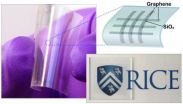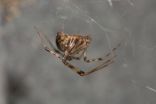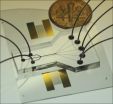(Press-News.org) HOUSTON – (Oct. 2, 2012) – Researchers at Rice University are designing transparent, two-terminal, three-dimensional computer memories on flexible sheets that show promise for electronics and sophisticated heads-up displays.
The technique based on the switching properties of silicon oxide, a breakthrough discovery by Rice in 2008, was reported today in the online journal Nature Communications.
The Rice team led by chemist James Tour and physicist Douglas Natelson is making highly transparent, nonvolatile resistive memory devices based on the revelation that silicon oxide itself can be a switch. A voltage run across a thin sheet of silicon oxide strips oxygen atoms away from a channel 5 nanometers (billionths of a meter) wide, turning it into conductive metallic silicon. With lower voltages, the channel can then be broken and repaired repeatedly, over thousands of cycles.
That channel can be read as a "1" or a "0," which is a switch, the basic unit of computer memories. At 5 nm, it shows promise to extend Moore's Law, which predicted computer circuitry will double in power every two years. Current state-of-the-art electronics are made with 22 nm circuits.
The research by Tour, Rice's T.T. and W.F. Chao Chair in Chemistry as well as a professor of mechanical engineering and materials science and of computer science; lead author Jun Yao, a former graduate student at Rice and now a post-doctoral researcher at Harvard; Jian Lin, a Rice postdoctoral researcher, and their colleagues details memories that are 95 percent transparent, made of silicon oxide and crossbar graphene terminals on flexible plastic.
The Rice lab is making its devices with a working yield of about 80 percent, "which is pretty good for a non-industrial lab," Tour said. "When you get these ideas into industries' hands, they really sharpen it up from there."
Manufacturers who have been able to fit millions of bits on small devices like flash memories now find themselves bumping against the physical limits of their current architectures, which require three terminals for each bit.
But the Rice unit, requiring only two terminals, makes it far less complicated. It means arrays of two-terminal memories can be stacked in three-dimensional configurations, vastly increasing the amount of information a memory chip might hold. Tour said his lab has also seen promise for making multi-state memories that would further increase their capacity.
Yao's discovery followed work at Rice on graphitic-based memories in which researchers saw strips of graphite on a silicon oxide substrate break and heal when voltage was applied. Yao suspected the underlying silicon oxide was actually responsible, and he struggled to convince his lab colleagues. "Jun quietly continued his work and stacked up evidence, eventually building a working device with no graphite," Tour said. "And still, others said, 'Oh, it was exogenous carbon in the system that did it!' Then he built it with no exposure to carbon on the chip."
Yao's paper detailing the silicon oxide mechanism appeared in Nature's Scientific Reports in January.
His revelation became the basis for the next-generation memories being designed in Tour's lab, where the team is building memories out of silicon oxides sandwiched between graphene – one-atom-thick ribbons of carbon – and attached to plastic sheets. There's not a speck of metal in the entire unit (with the exception of leads attached to the graphene electrodes).
The marriage of silicon and graphene would extend the long-recognized utility of the first and prove once and for all the value of the second, long touted as a wonder material looking for a reason to be, Tour said. He noted the devices not only show potential for radiation-hardened devices – several built at Rice are now being evaluated at the International Space Station – but also withstand heat up to about 700 degrees Celsius. That means they can be mounted directly atop integrated processors with no ill effects.
The lab is also building crossbar memories with embedded diodes to better manipulate control voltages, Tour said. "We've been developing this slowly to understand the fundamental switching mechanisms," he said. "Industries have flown in and looked at it, but we're doing basic science here; we don't package things nice and pretty, so what they see looks rudimentary.
"But this is now transitioning into an applied system that could well be taken up as a future memory system," he said.
INFORMATION:
Co-authors are Rice graduate students Yanhua Dai, Gedeng Ruan, Zheng Yan, and Lei Li; and Lin Zhong, an associate professor of electrical and computer engineering. Natelson is a professor of physics and astronomy and of electrical and computer engineering at Rice.
The research was supported by the David and Lucille Packard Foundation, the Texas Instruments Leadership University Fund, the National Science Foundation and the Army Research Office.
This news release can be found online at news.rice.edu.
Read the abstract at http://www.nature.com/ncomms/journal/v3/n10/full/ncomms2110.html
Follow Rice News and Media Relations via Twitter @RiceUNews
Related Materials:
In situ imaging of the conducting filament in a silicon oxide resistive switch:
http://www.nature.com/srep/2012/120131/srep00242/full/srep00242.html
Professor Tour gave a press conference on transparent memory chips during an American Chemical Society convention in March. View a video recording of the conference here: http://www.ustream.tv/recorded/21406611
Images for download:
http://news.rice.edu/wp-content/uploads/2012/09/Memory-1-web.jpg
Using graphene as crossbar terminals, Rice University researchers are following through on groundbreaking research that shows silicon oxide, one of the most common materials on Earth, can be used as a reliable computer memory. The memories are flexible, transparent and can be built in 3-D configurations. (Credit: Jun Yao/Rice University)
http://news.rice.edu/wp-content/uploads/2012/03/invisible-memory_on-plastic.jpg
A flexible, transparent memory chip created by researchers at Rice University. (Credit: Tour Lab/Rice University)
Located on a 300-acre forested campus in Houston, Rice University is consistently ranked among the nation's top 20 universities by U.S. News & World Report. Rice has highly respected schools of Architecture, Business, Continuing Studies, Engineering, Humanities, Music, Natural Sciences and Social Sciences and is home to the Baker Institute for Public Policy. With 3,708 undergraduates and 2,374 graduate students, Rice's undergraduate student-to-faculty ratio is 6-to-1. Its residential college system builds close-knit communities and lifelong friendships, just one reason why Rice has been ranked No. 1 for best quality of life multiple times by the Princeton Review and No. 4 for "best value" among private universities by Kiplinger's Personal Finance. To read "What they're saying about Rice," go to www.rice.edu/nationalmedia/Rice.pdf.
Visionary transparent memory a step closer to reality
Rice University making reliable 3-D memories from silicon oxide and graphene
2012-10-03
ELSE PRESS RELEASES FROM THIS DATE:
Starting antiretroviral therapy improves HIV-infected Africans' nutrition
2012-10-03
Starting HIV-infected patients on antiretroviral therapy reduces food insecurity and improves physical health, thereby contributing to the disruption of a lethal syndemic, UCSF and Massachusetts General Hospital researchers have found in a study focused on sub-Saharan Africa.
The study was published this week in the Journal of Acquired Immune Deficiency Syndromes.
With more than 20 million people infected with HIV/AIDS and almost 240 million people lacking access to enough food, sub-Saharan Africa is experiencing co-epidemics of food insecurity and HIV/AIDS that intensify ...
For elephants, deciding to leave watering hole demands conversation, Stanford study shows
2012-10-03
STANFORD, Calif. — In the wilds of Africa, when it's time for a family of elephants gathered at a watering hole to leave, the matriarch of the group gives the "let's-go rumble" — as it's referred to in scientific literature — kicking off a coordinated and well-timed conversation, of sorts, between the leaders of the clan.
First, the head honcho moves away from the group, turns her back and gives a long, slightly modulated and — to human ears — soft rumble while steadily flapping her ears. This spurs a series of back and forth vocalizations, or rumbles, within the group ...
University of Minnesota engineers invent new device that could increase Internet download speeds
2012-10-03
MINNEAPOLIS / ST. PAUL (10/02/2012) —A team of scientists and engineers at the University of Minnesota has invented a unique microscale optical device that could greatly increase the speed of downloading information online and reduce the cost of Internet transmission.
The device uses the force generated by light to flop a mechanical switch of light on and off at a very high speed. This development could lead to advances in computation and signal processing using light instead of electrical current with higher performance and lower power consumption.
The research results ...
1 glue, 2 functions
2012-10-03
Akron, Ohio, Oct. 2, 2012 — While the common house spider may be creepy, it also has been inspiring researchers to find new and better ways to develop adhesives for human applications such as wound healing and industrial-strength tape. Think about an adhesive suture strong enough to heal a fractured shoulder and that same adhesive designed with a light tackiness ideal for "ouch-free" bandages.
University of Akron polymer scientists and biologists have discovered that this house spider — in order to more efficiently capture different types of prey — performs an uncommon ...
Too little nitrogen may restrain plants' carbon storage capability, U of M paper shows
2012-10-03
MINNEAPOLIS / ST. PAUL (10/02/2012) —Plants' ability to absorb increased levels of carbon dioxide in the air may have been overestimated, a new University of Minnesota study shows.
The study, published this week in the journal Nature Climate Change, shows that even though plants absorb large amounts of carbon dioxide and actually can benefit from higher levels of it, they may not get enough of the nutrients they need from typical soils to absorb as much CO2 as scientists had previously estimated. Carbon dioxide absorption is an important factor in mitigating fossil-fuel ...
Acoustic cell-sorting chip may lead to cell phone-sized medical labs
2012-10-03
UNIVERSITY PARK, Pa. -- A technique that uses acoustic waves to sort cells on a chip may create miniature medical analytic devices that could make Star Trek's tricorder seem a bit bulky in comparison, according to a team of researchers.
The device uses two beams of acoustic -- or sound -- waves to act as acoustic tweezers and sort a continuous flow of cells on a dime-sized chip, said Tony Jun Huang, associate professor of engineering science and mechanics, Penn State. By changing the frequency of the acoustic waves, researchers can easily alter the paths of the cells.
Huang ...
Payoff lacking for casino comps
2012-10-03
A study of widely used complimentary offers at Atlantic City casinos finds that common giveaways such as free rooms and dining credits are less profitable – and lead to unhealthy competition among casinos – than alternative comps such as free travel and parking.
The research, co-authored by Seul Ki Lee, an assistant professor at Temple University's School of Tourism and Hospitality Management, analyzed monthly promotional allowance and expenditure data from 11 casinos in the Atlantic City market from 2008 to 2010. Atlantic City is the second largest gaming market in ...
Study reveals differences in overall health of Latino-American subgroups
2012-10-03
TALLAHASSEE, Fla. - Despite a shared Latino heritage, there are significant differences in the overall health and the use of health-care services among Cuban-Americans, Mexican-Americans and Puerto Rican-Americans — even between men and women in the same subgroup — according to two recently published studies by Florida State University researchers.
The authors, led by College of Social Work Professor and Associate Dean Amy L. Ai, evaluated the physical and behavioral health, as well as the health care service usage, of all three major Latino subgroups in the United States. ...
Cedars-Sinai study sheds light on bone marrow stem cell therapy for pancreatic recovery
2012-10-03
LOS ANGELES (Oct. 2, 2012) – Researchers at Cedars-Sinai's Maxine Dunitz Neurosurgical Institute have found that a blood vessel-building gene boosts the ability of human bone marrow stem cells to sustain pancreatic recovery in a laboratory mouse model of insulin-dependent diabetes.
The findings, published in a PLOS ONE article of the Public Library of Science, offer new insights on mechanisms involved in regeneration of insulin-producing cells and provide new evidence that a diabetic's own bone marrow one day may be a source of treatment.
Scientists began studying ...
NASA sees strong thunderstorms in Tropical Storm Gaemi
2012-10-03
Infrared NASA satellite imagery revealed that the strongest thunderstorms within Tropical Storm Gaemi in the western North Pacific Ocean were located around the storm's center and in a band of thunderstorms east of the center.
On Oct. 2, 2012 at 1500 UTC (11 a.m. EDT) Tropical Storm Gaemi had maximum sustained winds near 40 knots (46 mph/74 kph). It was located about 515 nautical miles (592 miles/954 km) east of Hue, Vietnam, near 15.3 North latitude and 116.7 East longitude. Gaemi is moving to the southeast at 9 knots (10 mph/16.6 kph).
Infrared imagery from the AIRS ...
LAST 30 PRESS RELEASES:
Making lighter work of calculating fluid and heat flow
Normalizing blood sugar can halve heart attack risk
Lowering blood sugar cuts heart attack risk in people with prediabetes
Study links genetic variants to risk of blinding eye disease in premature infants
Non-opioid ‘pain sponge’ therapy halts cartilage degeneration and relieves chronic pain
AI can pick up cultural values by mimicking how kids learn
China’s ecological redlines offer fast track to 30 x 30 global conservation goal
Invisible indoor threats: emerging household contaminants and their growing risks to human health
Adding antibody treatment to chemo boosts outcomes for children with rare cancer
Germline pathogenic variants among women without a history of breast cancer
Tanning beds triple melanoma risk, potentially causing broad DNA damage
Unique bond identified as key to viral infection speed
Indoor tanning makes youthful skin much older on a genetic level
Mouse model sheds new light on the causes and potential solutions to human GI problems linked to muscular dystrophy
The Journal of Nuclear Medicine ahead-of-print tip sheet: December 12, 2025
Smarter tools for peering into the microscopic world
Applications open for funding to conduct research in the Kinsey Institute archives
Global measure underestimates the severity of food insecurity
Child survivors of critical illness are missing out on timely follow up care
Risk-based vs annual breast cancer screening / the WISDOM randomized clinical trial
University of Toronto launches Electric Vehicle Innovation Ontario to accelerate advanced EV technologies and build Canada’s innovation advantage
Early relapse predicts poor outcomes in aggressive blood cancer
American College of Lifestyle Medicine applauds two CMS models aligned with lifestyle medicine practice and reimbursement
Clinical trial finds cannabis use not a barrier to quitting nicotine vaping
Supplemental nutrition assistance program policies and food insecurity
Switching immune cells to “night mode” could limit damage after a heart attack, study suggests
URI-based Global RIghts Project report spotlights continued troubling trends in worldwide inhumane treatment
Neutrophils are less aggressive at night, explaining why nighttime heart attacks cause less damage than daytime events
Menopausal hormone therapy may not pose breast cancer risk for women with BRCA mutations
Mobile health tool may improve quality of life for adolescent and young adult breast cancer survivors
[Press-News.org] Visionary transparent memory a step closer to realityRice University making reliable 3-D memories from silicon oxide and graphene




